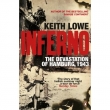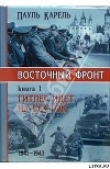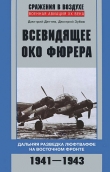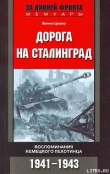
Текст книги "Rommel's Deutsches Afrika Korps 1941-1943"
Автор книги: Автор Неизвестен
Жанры:
История
,сообщить о нарушении
Текущая страница: 17 (всего у книги 19 страниц)
Oberstkutnant Cramer ordered another turn, because enemy tanks were then attacking the regiment's right flank. At the moment that the tanks' main guns opened fire again, the regimental command tank took a direct hit. Cramer felt one blow, and then another. When he reached for his head, his h-ind became bloody. He had been wounded by shrapnel on the arm and head.
Despite his personal wounding and the loss of many tanks, the main effort of the enemy had been thwarted. Major Fenski, the commander of the I./Panzer– Regiment 8° had done a great job directing the efforts of the other three tank companies of the battalion. Ik addition, 8.8-centimeter Flak on and in front of Hill 208 had thwarted a series of enemy attacks by nocking out a large number of enemy tanks.
The sharp edge of "Battleaxe" bad been blunted at this hill. In the official British history of the campaign written after the war, the fbllowing was stated about the resistance offered by a single 8.8 centimeter Flak battery on the hill
Operation "Battleaxe," which had started with such high hopes, failed, because the decisive Halfaya Position had not been taken, and it was not possible to proceed past Strongpoint 208. The bravery and the firepower of the opponents was too great. The German 88 proved to be a deadly weapon against all types of tanks. The combined effort of tanks employed with 8.8-centimeter Flak batteries that were positioned well forward was a surprise for the British leadership and an important factor for its defeat. Rommel's victory was a victory of his leadership, of his soldiers, who were fighting in a superior fashion, and of his better weapons.
It should be mentioned that the success of these two days of fighting cost Panzer-Regiment 8 50 of its available 80 tanks. The majority of the tanks lost were recovered in the days that followed and made operational again, however.
The 5. leichte Afrika-Division – to be redesignated the 21. Panzer-Division in August 1941 – started to gain ground in its sector on 16 June. With its Panzer-Regiment 5 in the lead, it had attacked out of the area west of Sidi Azeiz. Generalmajor von Ravenstein was the division's new commander. Rommel told von Ravenstein: "Move as rapidly as possible to the area northeast of Sidi Omar and continue the attack from there towards Sidi Suleiman."
This shifting of the Schwerpunkt of the operation was one of Rommel's recipes for success. He made an entry concerning it in his personal diary: "You can frequently decide a battle by simply changing the point of main effort, as long as it comes as a surprise to the enemy."
In order to make his new Schwerpunkt as strong as possible, he ordered all elements of the 15. Panzer-Division north of Capuzzo to be pulled out o: the line and moved to the left flank of the 5. leichte Afrika-Division. These elements would advance to Sidi Suleiman on the following morning and eject the enemy in conjunction with the 5. leichte Afrika-Division.
The reinforced Panzer-Regiment 5 moved out to attack at 0430 hours on 17 June. The enemy's initial resistance was overcome and Sidi Suleiman was reached and rapidly secured.
The I.Panzer-Regiment 8 of Major Fenski reached the enemy at approximately the same time. It rolled into the flank of the completely surprised enemy and opened fire. After a short, sharp exchange of fire, a number or enemy tanks were left knocked out on the battlefield. Sidi Suleiman was reached by this battalion as well. The tanks continued their advance from there, passing columns of Commonwealth trucks and tanks. The enemy had been caught in a trap.
At 0925 hours, Major General Creagh, the British commander in the trap, sent a radio message to the Commander of the Western Desert Forces, General Beresford-Peirse, that he needed to come to his command post. Major General Creagh did not know how to get out of this situation.
A short while later, the elements of Panzer-Regiment 5 that had advanced further reached the command post of Brigadier General Messervy and overran it. That action resulted in the British 4th Armoured Brigade becoming leaderless. When General Beresford-Peirse arrived at Major General Creagh's command post accompanied by General Wavell, he ordered the retreat of the British 7th Armoured Division. General Wavell, the overall Commander-in-Chief, approved the decision. General Wavell then flew back to Cairo, where he informed London that he regretted "to report that Battleaxe had failed."
The Summer Battle of Solluni had lasted 72 hours. It was the first time that all of the 15. Panzer-Division had been employed at the same time. The Commonwealth forces pulled back to their jump-off positions. Winston Churchill wrote the following in his diary: "Everything fell apart on 17 June."
Four days later, he sent an official message to General Wavell at his headquarters in Cairo:
I have come to the decision that the best public interest is served if General Auchinleck is named as Commander-in-Chief of the Army in the Near East in your place.
A second message was sent to General Auchinleck:
You are assuming this important command in a time of crisis. You shall provide special attention to the situation in Tobruk, to the bringing up of enemy reinforcements in Libya and to the fact that the Germans are now primarily occupied with the invasion of Russia. You must certainly realize yourself how important these problems are.
The war in the desert entered a period of stalemate. In its initial stages, rowever, it had demonstrated that armored formations also had great opportunities there. It also demonstrated that the question of logistical support was especially important. This would be shown more than once in the period to follow.
Feldmarshall Erwin Rommel
(15 November 1891 – 14 October 1944), popularly known as the Desert Fox.
He was a highly decorated officer in World War I, and was awarded the Pour le Mérite for his exploits on the Italian front. In World War II, he further distinguished himself as the commander of the 7th Panzer Division during the 1940 invasion of France. However, it was his leadership of German and Italian forces in the North African campaign that established the legend of the Desert Fox. He is considered to have been one of the most skilled commanders of desert warfare in the war. He later commanded the German forces opposing the Allied cross-channel invasion in Normandy.
As one of the few generals who consistently fought the Western Allies (he was never assigned to the Eastern Front), Rommel is regarded as having been a humane and professional officer. His Afrikakorps was never accused of war crimes. Soldiers captured during his Africa campaign were reported to have been treated humanely. Furthermore, he ignored orders to kill captured commandos, Jewish soldiers and civilians in all theaters of his command.
Late in the war, Rommel was linked to the conspiracy to kill Adolf Hitler. Due to his wide renown, Hitler chose to eliminate him quietly; in trade for the protection of his family, Rommel agreed to commit suicide.
Rommel was born on 15 November 1891 in Heidenheim, 45 kilometres (28 mi) from Ulm, in the Kingdom of Württemberg (then part of the German Empire). He was baptised on 17 November 1891. He was the second child of the Protestant headmaster of the secondary school at Aalen, Professor Erwin Rommel Senior (1860–1913), and Helene von Luz, who had two other sons and a daughter. Rommel wrote that "my early years passed quite happily."

At age 14, Rommel and a friend built a full-scale glider that was able to fly short distances. Rommel even considered becoming an engineer and throughout his life displayed extraordinary technical aptitude. Acceding to his father's wishes, Rommel instead joined the local 124th Württemberg Infantry Regiment as an officer cadet in 1910 and was sent to the Officer Cadet School in Danzig. He graduated on 15 November 1911 and was commissioned as a lieutenant in January 1912.
While at Cadet School, Rommel met his future wife, 17-year-old Lucia Maria Mollin (commonly called Lucie). They married on 27 November 1916 in Danzig and on 24 December 1928 had a son, Manfred Rommel, who later became the Mayor of Stuttgart. Some historians believe Rommel also had a relationship with Walburga Stemmer in 1913, which allegedly produced a daughter, Gertrud.
During World War I, Rommel fought in France as well as in Romania (see: Romanian Campaign) and Italy (see: Italian Campaign), first in the 6th Württemberg Infantry Regiment, but through most of the war in the Württemberg Mountain Battalion of the elite Alpenkorps. He gained a reputation for great courage, making quick tactical decisions and taking advantage of enemy confusion. He was wounded three times and awarded the Iron Cross, First and Second Class. Rommel also received Prussia's highest award, the order of Pour le Mérite, after fighting in the Battles of the Isonzo in the mountains west of Slovenia on the Soča front. The award was for the Battle of Longarone and the capture of Mount Matajur and its Italian defenders, which totalled 150 officers, 9,000 men, and 81 artillery pieces. For a time, he served in the same infantry regiment as Friedrich Paulus. While fighting at Isonzo, Rommel was caught behind Italian lines but managed to escape capture, though almost all of his staff were taken prisoner. In the Second World War, when the Germans and Italians were allies, Rommel tempered his initial disdain of Italian soldiers, when he realized that their lack of success was principally due to poor leadership and equipment. When these difficulties were overcome they were equal to German forces. Erwin Rommel wrote a book, Infantry Attacks, in which he examined and analyzed the many battles he fought in during World War I. It was published in 1937 and became essential reading for both German and allied commanders during World War II. He taught his men to dig in whenever they paused for any length of time. This paid off many times when French artillery fired upon his position, only to be shrugged off by the entrenchments built by Rommel's men.

Rommel turned down a post in the Truppenamt (the camouflaged General Staff), whose existence was forbidden by the Treaty of Versailles—the normal path for advancing to high rank in the German army. Instead, he preferred to remain a frontline officer.
Rommel held battalion commands and was an instructor at the Dresden Infantry School from 1929 to 1933. In 1934, his book for infantry training, “Gefechts-Aufgaben für Zug und Kompanie : Ein Handbuch für den Offizierunterricht“ (Combat tasks for platoon and company: A manual for the officer instruction), appeared. This book was printed until 1945 in five editions, with revisions and changes of title. From 1935 to 1938, Rommel held commands at the Potsdam War Academy. Rommel's war diaries, Infanterie greift an (Infantry Attacks), published in 1937, became a highly regarded military textbook and attracted the attention of Adolf Hitler, who placed Rommel in charge of the War Ministry liaison with the Hitler Youth's (Hitler Jugend), Headquarters of Military Sports, the branch involved with paramilitary activities, primarily terrain exercises and marksmanship. Rommel applied himself energetically to the task. The army provided instructors to the Hitler Youth Rifle School in Thuringia, which in turn supplied qualified instructors to the HJ's regional branches.
In 1937, Rommel conducted a tour of Hitler Youth meetings and encampments and delivered lectures on German soldiering while inspecting facilities and exercises. Simultaneously, he was pressuring Baldur von Schirach, the Hitler Youth leader, to accept an agreement expanding the army's involvement in Hitler Youth training. Schirach interpreted this as a bid to turn the Hitler Youth into an army auxiliary, a "junior army" in his words. He refused and denied Rommel (whom he had come to dislike personally, apparently out of envy for his "real soldier's" appeal) access to the Hitler Youth. An agreement was concluded, but on a far more limited scope than Rommel sought; cooperation was restricted to the army's providing personnel to the rifle school. By 1939 the Hitler Youth had 20,000 rifle instructors. Simultaneously, Rommel retained his place at Potsdam. Rommel was awarded the highest war ribbons for excellent performance.
In 1938 Rommel, now a colonel, was appointed Kommandant (commander) of the War Academy at Wiener Neustadt (Theresian Military Academy). Rommel was removed after a short time, however, to take command of Adolf Hitler's personal protection battalion (FührerBegleitbataillon), assigned to protect him in the special railway train (Führersonderzug) used during his visits to occupied Czechoslovakia and Memel. It was during this period that he met and befriended Joseph Goebbels, the Reich's minister of propaganda. Goebbels became a fervent admirer of Rommel and later ensured that Rommel's exploits were celebrated in the media.
Poland 1939Rommel acted as commander of the Führerbegleithauptquartier (Führer escort headquarters) during the Poland campaign, often moving up close to the front in the Führersonderzug and seeing much of Hitler. After the Polish defeat, Rommel returned to Berlin to organize the Führer's victory parade, taking part himself as a member of Hitler's entourage. During the Polish campaign, Rommel was asked to intervene on behalf of one of his wife's relatives, a Polish priest who had been arrested. When Rommel applied to the Gestapo for information, the Gestapo found no information about the man's existence. France 1940
Rommel asked Hitler for command of a panzer division. On 6 February 1940, three months before the invasion of France, Rommel was given command of the 7th Panzer Division, for Fall Gelb ("Case Yellow"), the invasion of France and the Low Countries. This promotion provoked resentment among some of his fellow officers. Rommel's initial request for command had been rejected by the Chief of Army Personnel, who cited his lack of previous experience with armoured units and his extensive prior experience in an Alpine unit made him a more suitable candidate to assume command of a mountain division that had recent need to fill its commanding officer post. Rommel had, however, emphasized the use of mobile infantry and recognized the great usefulness of armoured forces in the Poland campaign. He set about learning and developing the techniques of armoured warfare with great enthusiasm. The decision to place him in command of an armoured division was borne out to be an excellent one. In May, 1940 his 7th Panzer Division became known as the "Ghost Division" because its rapid advances and fast paced attacks often placed them so far forward that they were frequently out of communication with the rest of the German army.
Invasion of France and Belgium
On 10 May 1940 a part of XV Corps under General Hoth, advanced into Belgium to proceed to the Meuse river near the Walloon municipality of Dinant. At the Meuse, 7th Panzer was held up owing to the bridges having been destroyed and to determined sniper and artillery fire from the Belgian defenders. The Germans lacked smoke grenades, so Rommel, having assumed personal command of the crossing, ordered a few nearby houses to be set on fire to conceal the attack. The German Panzergrenadiers crossed the river in rubber boats, with Rommel leading the second wave. The Division dashed further inland, always spurred on by Rommel and far in front of any friendly forces.

Rommel's technique of pushing forward boldly, ignoring risks to his flanks and rear and relying on the shock to enemy morale to hinder attacks on his vulnerable flanks, paid large dividends during his rapid march across France. When encountering resistance, Rommel would simply order his tanks forward, all guns blazing, relying on the shock of the sudden assault to force the enemy to surrender. This method offset the disadvantage the German tanks had in terms of armour and low-calibre guns, often causing large formations of enemy heavy tanks to simply give up a fight they would otherwise have had a good chance of winning. This approach, although it saved lives on both sides by avoiding prolonged engagements, did cause mishaps. On one occasion his tanks, following this tactic, closed with a convoy of French trucks and fired into them only to realise that the trucks were acting as ambulances ferrying wounded from the front. [29]
Battle of Arras
By 18 May the Division had captured Cambrai, but here Rommel's advance was checked briefly. His chief of staff, still with the unmotorized part of the Division in Belgium and not having received radio reports from Rommel, had written off Rommel and his combat group as lost and so had not arranged for fuel to be sent up.There was a degree of controversy over this issue, with Rommel furious at what he perceived as a negligent attitude on the part of his supply officers, whereas his chief of staff was critical of Rommel's failure to keep his staff officers up to speed on his actions.
On 20 May Rommel's tanks reached Arras. Here he wanted to cut off the British Expeditionary Force from the coast and Hans von Luck, commanding the reconnaissance battalion of the Division, was tasked with forcing a crossing over the La Bassée canals near the city. Supported by Stuka dive bombers, the unit managed to cross after which the British launched a counterattack (the Battle of Arras) on 21 May. Facing the British Matilda tanks, the Germans found their 3.7-cm guns useless against the heavy armour and a battery of 88 mm guns had to be brought up to deal with the threat, with Rommel personally directing the fire.
After Arras, Hitler ordered his tanks to hold their positions, while the British, in Operation Dynamo, evacuated their troops at Dunkirk, and the 7th Panzer Division was given a few days of much-needed rest. On 26 May, 7th Panzer continued its advance, reaching Lille on 27 May. For the assault on the town, General Hoth placed his other tank division, 5th Panzer Division, under Rommel's command, to the chagrin of its commander, General Max von Hartlieb. The same day, Rommel received news that he had been awarded the Knight's Cross of the Iron Cross; the first divisional commander to be so honoured during the campaign. This award, which had been secured for Rommel at Hitler's behest, caused more animosity among fellow officers, who were critical of Rommel's close relationship with Hitler. They believed that this was further evidence that Hitler seemed to give Rommel preferential treatment.
On 28 May, while making the final push into Lille and far in front of friendly forces, 7th Panzer came under heavy fire from French artillery. Rommel drove his forces on, capturing Lille, trapping half of the French First Army, and preventing their retreat to Dunkirk. After this coup, Rommel's forces were again given time to rest.
Drive for English Channel
Rommel, resuming his advance on 5 June, drove for the River Seine to secure the bridges near Rouen. Advancing 100 kilometres (62 mi) in two days, the division reached Rouen only to find the bridges destroyed. On 10 June, Rommel reached the coast near Dieppe, sending his "Am at coast" signal to the German HQ.
On 15 June, 7th Panzer started advancing on Cherbourg. On 17 June, the Division advanced 35 kilometres (22 mi), capturing the town on the following day. The Division then proceeded towards Bordeaux but stopped when the armistice was signed on 21 June. In July, the Division was sent to the Paris area to start preparations for Operation Seelöwe, Sea Lion the planned invasion of Britain. The preparations were half-hearted, however, as it soon became clear that the Luftwaffe would not be able to secure air superiority over the Royal Air Force.
Ghost Division
7. Panzer-Division was later nicknamed Gespenster-Division (the "Ghost Division"), because of the speed and surprise it was consistently able to achieve, to the point that even the German High Command at times lost track of its whereabouts. It also set the record for the longest thrust in one day by tanks up to that point, covering nearly 200 miles (320 km).
Rommel received both praise and criticism for his tactics during the French campaign. Many, such as General Georg Stumme, who had previously commanded 7th Panzer Division, were impressed with the speed and success of Rommel's drive; however, others were more reserved, some out of envy, others because they felt Rommel took unnecessary risks. Hermann Hoth publicly expressed praise for Rommel's achievements but had private reservations, saying in a confidential report that Rommel should not be given command over a corps unless he gained "greater experience and a better sense of judgment.»Hoth also accused Rommel of an unwillingness to acknowledge the contributions of others to his victories.
The Fourth Army commander, General Günther von Kluge, also criticised Rommel for falsely claiming all the glory for his achievements. Rommel did not, Kluge felt, acknowledge the contribution of the Luftwaffe, and Rommel's manuscript describing his campaign in France misrepresented the advances of neighbouring units to elevate the achievements of his own dazzling advances. Kluge also cited the complaint by General Hartlieb that Rommel had misappropriated 5th Panzer's bridging tackle on 14 May after his own supplies had run out in order to cross the Meuse, delaying 5th Panzer for several hours. Rommel had repeated this procedure on 27 May at the River Scarpe crossing.
North Africa 1941–1943
Rommel's reward for his success was to be promoted and appointed commander of the 5th Light Division (later reorganised and redesignated 21.Panzer-Division) and of the 15.Panzer-Division which, as the Deutsches Afrikakorps,( listen (help·info)) were sent to Libya in early 1941 in Operation Sonnenblume to aid the demoralised Italian troops which had suffered a heavy defeat from British Commonwealth forces in Operation Compass. It was in Africa where Rommel achieved his greatest fame as a commander.
His campaign in North Africa earned Rommel the nickname "The Desert Fox." On 6 February 1941 Rommel was ordered to lead the Afrika Korps, sent to Italian Libya to help shore up the Italian forces which had been driven back during Operation Compass, launched by British Commonwealth forces under Major-General Richard O'Connor during December 1940. Initially ordered to assume a defensive posture and hold the front line, the Axis High Command had slated a limited offensive towards Agedabia and Benghazi for May, planning then to hold the line between those cities. Rommel argued that such a limited offensive would be ineffective, as the whole of Cyrenaica would have to be captured if the front lines were to be held. The task of even holding the remaining Italian possessions seemed daunting, as the Italians had only 7,000 troops remaining in the area after O'Connor's successful capture of 130,000 prisoners and almost 400 tanks during the previous three months of advance.
On 24 March 1941 Rommel launched a limited offensive with only the 5th Light Division supported by two Italian divisions. This thrust was to be minor, in anticipation of Rommel receiving the 15th Panzer Division in May. The British, who had been weakened by troops being withdrawn to fight in the Battle of Greece, fell back to Mersa el Brega and started constructing defensive works. Rommel decided to continue the attack against these positions in order to prevent the British from building up the fortifications. After a day of fierce fighting, the Germans prevailed and the advance continued as Rommel disregarded holding off the attack on Agedabia until May. The British Commander-in-Chief Middle East Command, General Archibald Wavell, overestimating the strength of the Axis forces and already apprehensive about the extent of his advances during the previous winter, ordered a withdrawal from Benghazi in early April to avoid being cut off by Rommel's thrust.
Rommel, seeing the British reluctance to fight a decisive action, decided on a bold move: the seizure of the whole of Cyrenaica despite having only light forces. He ordered the Italian Ariete armoured division to pursue the retreating British while the 5th Light Division was to move on Benghazi. Generalmajor Johannes Streich, the 5th Light Division's commander, protested this order on the grounds of the state of his vehicles, but Rommel brushed the objections aside because, in his words, "One cannot permit unique opportunities to slip by for the sake of trifles. The Italian Commander-in-Chief, General Italo Gariboldi, tried repeatedly to halt Rommel's advance but was unable to contact him.
After Benghazi had been secured following the British withdrawal, Cyrenaica as far as Gazala was captured by 8 April. This was despite fervent protests from Italian GHQ, which felt Rommel was going beyond his orders, especially since he was supposedly under Italian command. Rommel had received orders from the German High Command that he was not to advance past Maradah, but he turned a blind eye to this as well as to protests from some of his staff and divisional commanders. He believed he was grasping a great possibility to largely destroy the Allied presence in North Africa and capture Egypt. Rommel decided to keep up the pressure on the retreating British and launched an outflanking offensive on the important port of Tobruk during which he managed to capture on 9 April the Military Governor of Cyrenaica, Lieutenant-General Philip Neame as well as O'Connor, who at this time was his advisor. With Italian forces attacking along the coast, Rommel decided to sweep around to the south and attack the harbour from the southeast with the 5th Light Division, hoping to trap the bulk of the enemy force there. This outflanking could not be carried out as rapidly as was necessary owing to logistical problems from lengthening supply lines and spoiling flank attacks from Tobruk, so Rommel's plan failed. By 11 April the envelopment of Tobruk was complete and the first attack was launched. Other forces continued pushing east, reaching Bardia and securing the whole of Libya by 15 April.
Plot against Hitler
There had always been opposition to Hitler in conservative circles and in the Army, the Schwarze Kapelle (Black Orchestra), but Hitler's dazzling successes in 1938–1941 had stifled it. However, after the Russian campaign failed, and the Axis suffered more defeats, this opposition underwent a revival.
Early in 1944, three of Rommel's closest friends—Karl Strölin, Alexander von Falkenhausen and Carl Heinrich von Stülpnagel—began efforts to bring Rommel into the conspiracy. They felt that as by far the most popular officer in Germany, he would lend their cause badly needed credibility with the populace. Additionally, the conspirators felt they needed the support of a field marshal on active duty. Erwin von Witzleben, who would have become commander-in-chief of the Wehrmacht if Hitler had been overthrown, was a field marshal, but had not been on active duty since 1942. Sometime in February, Rommel agreed to lend his support to the conspiracy in order to, as he put it, "come to the rescue of Germany.»
Rommel, however, opposed assassinating Hitler. After the war, his widow—among others—maintained that Rommel believed an assassination attempt would spark civil war in Germany and Austria and Hitler would have become a martyr for a lasting cause. Instead, Rommel insisted that Hitler be arrested and brought to trial for his crimes. By the time of his head injuries, Rommel had made up his mind to do his part to get rid of Hitler.
After the failed bomb attack of 20 July, many conspirators were arrested and the dragnet expanded to anyone even suspected of participating. Rommel was fairly perturbed at this development, telling Hans Speidel that Hitler's behavior after the attack proved that the dictator had "gone completely mad." It did not take long, however, for Rommel's involvement to come to light. His name was first mentioned when Stülpnagel blurted it out after a botched suicide attempt. Later, another conspirator, Caesar von Hofacker, admitted under particularly severe Gestapo torture that Rommel was actively involved.
Additionally, Carl Goerdeler, the main civilian leader of the Resistance, wrote on several letters and other documents that Rommel was a potential supporter and an acceptable military leader to be placed in a position of responsibility should their coup succeed. Nazi party officials in France reported that Rommel extensively and scornfully criticised Nazi incompetence and crimes.

Rommel's death
The "Court of Military Honour," a drumhead court-martial convened to decide the fate of officers involved in the conspiracy, included two men with whom Rommel had crossed swords before, Heinz Guderian and Gerd von Rundstedt. The Court decided that Rommel should be expelled from the Army in disgrace and brought before Roland Freisler's People's Court, a kangaroo court that always decided in favour of the prosecution. However, Hitler knew that having Rommel branded as a traitor would severely damage morale on the home front. He and Keitel thus decided to offer Rommel a chance to commit suicide.
Rommel was approached at his home by Wilhelm Burgdorf and Ernst Maisel, two generals from Hitler's headquarters, on 14 October 1944. Burgdorf informed him of the charges and offered him a choice: he could face the People's Court or choose to commit suicide quietly. In the former case, his staff would have been arrested and his family would suffer even before the all-but-certain conviction and execution. In the latter case, the government would assure his family full pension payments and a state funeral claiming he had died a hero. Burgdorf had brought a capsule of cyanide for the occasion. After a few minutes' thought alone, Rommel announced that he chose to end his own life and explained his decision to his wife and son. Carrying his field marshal's baton, Rommel went to Burgdorf's Opel, driven by SS Master Sergeant Heinrich Doose, and was driven out of the village. Doose walked away from the car leaving Rommel with Maisel. Five minutes later Burgdorf gestured to the two men to return to the car, and Doose noticed that Rommel was slumped over, after taking the cyanide pill. Doose, while sobbing, replaced Rommel's fallen cap on his head. Ten minutes later the group phoned Rommel's wife to inform her that Rommel was dead. [30]








